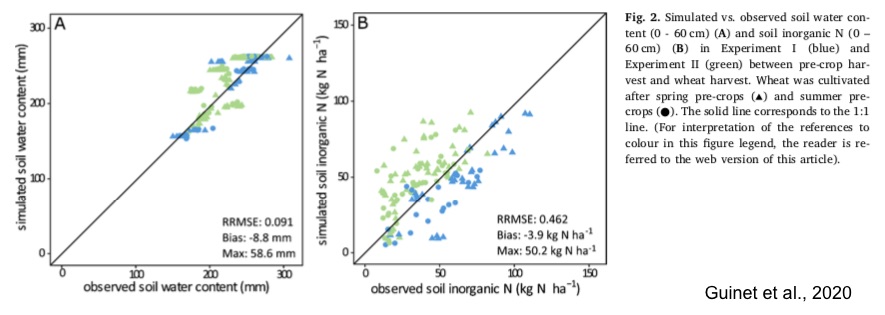ProSys
|
Article scientifique Maé Guinet, Bernard Nicolardot, Anne-Sophie Voisin Nitrogen benefits of ten legume pre-crops for wheat assessed by field measurements and modelling European Journal of Agronomy, 2020, 120, 126151. The positive effect of grain legume pre-crops on the yield of the subsequent crop has been studied widely, whereas less information is available on the nitrogen (N) processes related to this positive effect, especially for a wide range of grain legume species.The objective was to quantify and understand the effect of grain legume compared to cereal pre-crops (sown in 2014 and 2016) on grain and shoot N yields and shoot N concentration of wheat (Triticum aestivum) grown the following year (2015 and 2017). Spring legumes (faba bean (Vicia faba), fenugreek (Trigolia foenum-graecum), common vetch (Vicia sativa), lentil (Lens culinaris), lupin (Lupinus albus), and pea (Pisium sativum)) were com- pared to barley (Hordeum vulgare). Summer legumes (chickpea (Cicer arietinum), common bean (Phaseolus vul- garis), soybean (Glycine max) and Narbonne vetch (Vicia narbonensis)) were compared to sorghum (Sorghum bicolor). Inorganic N remaining in the soil at pre-crop harvest (N sparing) was measured. The STICS model which accurately predicted soil humidity and soil inorganic N in the pedoclimatic conditions of the field experiments was used to calculate N mineralisation from pre-crop residues and N leaching between pre-crop harvest and wheat harvest. Grain and shoot N yields of unfertilised N wheat were respectively 27 and 25 % higher after faba bean and lentil compared to barley pre-crops, and 66 and 51 % higher after summer legumes compared to sorghum pre- crop. In the second experiment, N fertilisation reduced the positive effect of fenugreek, and lentil on wheat yield compared to barley while it did not modify the pre-crop effect of the other legumes. A positive relationship between N mineralisation from pre-crop residues and wheat shoot N yield was established, with higher amounts of N available for the subsequent wheat after legume pre-crops. In 2014, N sparing was higher after spring pre- crops compared to summer pre-crops inducing higher N leaching after spring legume pre-crops, especially in the first experiment which was characterised by heavy rain in summer and autumn. Estimating N availability by taking into account N sparing, N mineralisation from soil and pre-crop residues and N leaching explained 49 % of wheat shoot N yield variability. Unquantified N processes and non-N processes might also have contributed to the positive effects of legumes on the subsequent wheat. Keywords: pre-crop effect, grain legumes, crop residues, mineralisation, N leaching A consulter ici : https://doi.org/10.1016/j.eja.2020.126151  |